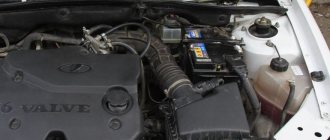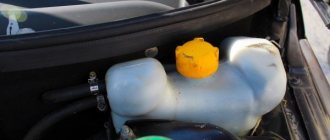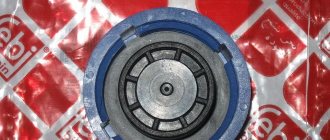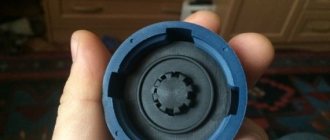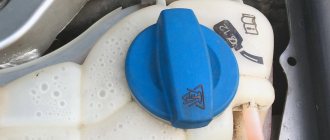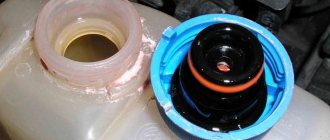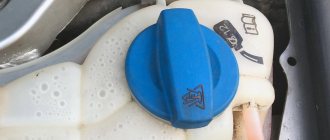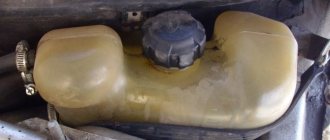Why is antifreeze leaking?
An antifreeze leak on a Priora occurs due to a leak in the system. For example, when cracks appear in the pipes, destruction of gaskets between the water pump and thermostat, as well as due to the formation of cracks in radiators.
All breakdowns associated with antifreeze leaks are a wide-ranging problem that can take from 15 minutes to a whole day to fix.
The antifreeze is gone, what can I add?
Quite often, a problem with antifreeze leakage occurs on the road and takes the driver by surprise. Since you can’t drive a car without coolant, you need to top it up to the level, but where can you get it if this happens suddenly?
It is recommended to always have at least one liter of coolant in your car. If there is no coolant in the car, you can add regular water and drive to the nearest station. Subsequently, after adding water to the system, when the breakdown is eliminated, it must be washed and filled with new coolant.
Reference
Antifreeze is the international name for car coolant. It is used to reduce t0 of the power unit and prevent its premature failure. Previously, distilled water and antifreeze were used for these purposes. Antifreeze needs to be changed at least once every two years. During vehicle operation, its level is monitored by special sensors in real time. When its quantity decreases, the car’s computer system notifies the driver of the problem: a warning is displayed on the instrument panel.
Where does antifreeze come from on Priora: Locations
There are many places where coolant can leak on a Priora car, but we will look at the most common places for antifreeze leaks and how to deal with them.
Pipes
Most often, antifreeze leaks in Priora occur from under the pipes, which become harder over time and begin to leak liquid. This problem can be solved by replacing the pipes with new ones or using a sealant.
Expansion tank
Sometimes it happens that over time the expansion tank cracks or chafes, which leads to coolant leakage. This problem can be solved quite simply, which does not even require draining the cooling liquid.
Gaskets
Quite often, a leak forms between the joints of the pump and the cylinder head, as well as the thermostat and the cylinder head. It occurs due to the destruction of the gasket that is installed between these parts to seal the connection.
Pump leaking
Often the seal on the pump ages and loses its elasticity, which leads to coolant leakage. This problem is dangerous because coolant getting on the timing belt can cause it to break, and on a Priora, a timing belt break leads to bending of the valves and expensive repairs. If the pump begins to leak, it cannot be repaired, but only needs to be replaced with a new one.
Radiator leaks
The Priora has two cooling radiators and stoves, both of which are prone to leakage, which undoubtedly leads to antifreeze leakage. If any of the radiators are leaking, they must be replaced with a new one.
Blown cylinder head gasket
One of the most problematic antifreeze leaks. With such a breakdown, antifreeze begins to flow either outward or inward into the cylinder, thereby getting into the engine oil, which can adversely affect the operation of the engine. This problem is quite difficult to fix, but it is possible. To solve this problem, it is necessary to remove the cylinder head and, in some cases, even grind it on a milling machine.
Troubleshooting
The extent of repair work will depend on the nature of the problem. As a rule, if you notice a problem in the early stages, you can deal with the breakdown yourself.
But otherwise, when the problem was discovered a long time ago and nothing was done to fix it, you need to contact a service station or a car repairman.
During the cold season. Such breakdowns in the winter are a very common occurrence, especially for older cars. The reason for this is a decrease in the volume of antifreeze under the influence of low temperatures. Subsequently, it becomes necessary to constantly add it to the expansion tank. This situation indicates that everything is in order with the cooling system. This only confirms the usual reaction of antifreeze in cold weather.
Sometimes drivers dilute antifreeze with water. But such actions are not always justified. This can lead to serious consequences, such as engine failure. Today, there are two types of antifreeze in car stores - ready-to-use and concentrated. Only concentrated substances can be diluted with water.
By adding distilled water to a ready-made liquid, you can significantly disrupt its beneficial properties, which will lead directly to failure. Therefore, before diluting antifreeze with water, you need to study the instructions from the manufacturer.
Violation of the tightness of the expansion tank
If antifreeze leaks, there may be different reasons. Depressurization of the tank is one of them. If the structure of the tank is damaged, then the corresponding antifreeze stains will not be visible on it. This happens due to the evaporation of working fluid from the tank due to its depressurization.
Therefore, if a leak of coolant in large volumes is detected, it is necessary to conduct a visual inspection of the expansion tank for mechanical damage. It is quite difficult to restore the tank yourself, so it is better to replace it immediately.
Expansion tank
If the expansion tank body and/or the caps with the gasket on it are old, then there is a high probability that they have microcracks. Another option is to skip the safety valve on said lid. The simplest thing in this case is to replace the cover and install a new gasket. More difficult is to replace the entire tank (including the lid).
Damage to conductors
In this case, coolant stains will be visible. Finding an antifreeze leak when the conductors are damaged is not difficult. Working fluid can leak not only when the car is running, but also when the engine is turned off.
If characteristic stains from antifreeze are observed the next morning, it is necessary to inspect all connections and components. But before starting work, you need to turn off the engine and wait until the temperature in the system normalizes.
During repair work, it is necessary to check all connections for mechanical damage. They can occur in any part of the system or hose. If certain parts are not visible due to poor access, a mirror can be used. When a certain hose is already very old and completely cracked, the leak can only be removed by completely replacing it. Diagnosis is best done in good lighting.
The cause of the leak may be poorly clamped clamps, as well as dried out rubber seals. In this case, antifreeze leaks from the pipes can be eliminated by replacing the seals and clamps. Timely repairs and diagnostics will help avoid big problems if antifreeze is leaking.
Where does antifreeze go if there are no leaks?
Where does antifreeze go if there are no leaks? Only a small portion of antifreeze leaks from the cooling system can be visually detected. The lion's share of leaks occurs in places that are inaccessible for inspection.
Visually you can determine the condition of the pipes. Presence of cracks in them. There will be liquid discharge in these places. Connection points for hoses and pipes. They leak very often. Because over time the pipes become rougher. They cease to be elastic. Metal bends from the radiator and engine block. The temperature action of the mouth expands. As they decrease, they become narrower. Therefore, when the engine cools down, the pipes narrow. Rubber technical products do not fit them. As a result, cracks form when the engine cools down. In these places, fluid is released. A more accurate way to increase leakage on a cold engine is to create an air pressure in the system of no more than 2 atmospheres. All weak points will immediately show a leak.
The cooling radiator is exposed to external factors. Such as getting hit by small pebbles while the car is moving. At speed, they can damage the radiator honeycombs. If the radiator is copper, cracks form at the soldering points. Plastic expansion tanks burst at the junction of the pipes.
All these points can be detected without problems with a thorough examination. If you create air pressure in the system, you can find weak points that will soon begin to create a problem.
For example, on a Priora car there is a weak point in the expansion tank. The bottom of the expansion tank bursts. Antifreeze comes out of the crack and flows down the wall of the car body. The place where the antifreeze flows is very difficult to see. You have to add more regularly.
Obvious damage
Antifreeze is designed to cool a car engine. A liquid with many additives is used in warm and cold seasons. Most compounds allow you to operate the machine at temperatures below - 60 degrees. A complete lack of coolant in the system will lead to rapid overheating of the engine, it will jam, and the car will fail. It is very expensive to overhaul the most expensive element in a car, so you need to carefully monitor the technical condition of all elements . The most common breakdowns that can lead to a rapid noticeable loss of antifreeze levels are:
Heater core leak
The most unpleasant place where antifreeze goes is if there are no external leaks. may occur in the interior heater core. The heating radiator can be copper or aluminum. Copper radiators are more resistant to the aggressive environment created by antifreeze. But aluminum ones are less reliable.
Especially if the system uses antifreeze that is not intended for use in a system with aluminum radiators. You cannot use G 12 antifreeze as it contains only carboxylate additives that cannot protect internal surfaces from the effects of ethylene glycol. It is part of antifreeze and antifreeze.
In addition to the corrosion of the radiator by antifreeze, cracks occur. The pipes are tanning. And they seal the joints poorly. A clear sign that antifreeze is leaking from the heater. What will happen is that antifreeze will begin to accumulate under the mat. If there are no external signs that the antifreeze is leaving, the first thing you need to check is. Antifreeze traces appearing under the mat. And if there is one, you will have to remove the heater. The procedure is expensive. Because the designs of many cars provide for the removal of the heater radiator by removing the front panel of the passenger compartment.
You can temporarily try to solve this problem without removing the radiator. Fill the system with sealant. To eliminate leaks in the system. It is advisable to use liquid sealant. The amount of sealant required to fix the leak is written in the instructions. Depending on the volume of coolant used.
Sometimes sealants work very well. Its operating principle is as follows. The composition contains a substance. Which when interacting with air. When antifreeze leaks from the system. The substance thickens and hardens. This tightens the leakage area. Therefore, it is advisable not to be greedy and use branded sealants. Having a good reputation.
Antifreeze in the combustion chamber.
The most insidious place where antifreeze goes is if it does not leak anywhere. Damage to the cylinder head gasket. As a result of overheating, even slight. May loosen the tightening point of the cylinder head to the cylinder block. The gasket will loosen.
Antifreeze has good fluidity. By loosening the gasket, it will begin to flow into the combustion chamber. In the first stages, the leakage will be insignificant. Typically when the engine is cold. When heated, the metal parts of the engine will become hot. And expand. The leak will stop. The leak will not have any effect on engine operation. At the initial stage, there will be no release of gases into the cooling system. But antifreeze will leave the expansion tank. On a cold engine.
Leak detection using an endoscope
This fault is very difficult to detect. You can, of course, use a special endoscope camera. It penetrates inside the cylinders and you can clearly see what is happening there. If there is a leak, it can be seen. But such a camera is not always available. The cost of the BOSCH 0601241200 endoscope is quite high. but you can find cheaper options. Accordingly, the image quality is different.
A method that allows you to identify many engine malfunctions. This is removing the pan. If you remove the pan, you will see the crankshaft, connecting rods, pistons, liners.
When antifreeze enters the combustion chamber, it burns and is discharged into the exhaust pipe. Even if a small amount accumulates, it will also be pushed out of the chamber.
Visual inspection
Antifreeze has good fluidity. Some of it penetrates between the piston rings under the piston. Therefore, a trace of antifreeze leakage will definitely appear on the inside of the liner. And if you wait a long time. Depending on how forcefully the antifreeze flows out. A drop appears on the lower edge of the sleeve, the color of the filled antifreeze. Naturally, there will be a mark on the sleeve from the runoff.
And it is important to decide on which side of the glass sleeve the drop is coming from. It can form from a leak on the outside of the liner. Due to the occurrence of a crack. On many engines the liners are removable. They are inserted into the engine block and sealed with either copper or rubber rings.
Rubber rings become hard over time. Copper rings sag. Therefore, antifreeze leaks from under the liners. If there is a drop of antifreeze present. It is necessary to carefully determine which side of the sleeve the glass is on.
If the leak occurs on the inside of the liner. The head gasket will most likely need to be replaced. If on the arc side, then these are o-rings. If the sleeves are removable. Otherwise, you need to look for a crack in the engine block. The leak can be increased by creating a pressure in the cooling system of no more than 2 atm. Higher pressure can damage the radiator honeycombs.
Antifreeze leak: what are the main causes and how to diagnose the problem
The leak itself is only a symptom of some kind of malfunction. We have already figured out what to do when a leak is detected. Now let's figure out how to understand what exactly the problem is.
Find out the main possible signs and causes of an antifreeze leak.
A seemingly simple cooling system is insidious in that it directly cools the engine, and therefore antifreeze can leak not only outside, but also inside – into the engine. So, we list the main signs that there are problems in the cooling system:
- puddles and wet spots under the car;
- wet floor in the cabin (and the liquid feels oily to the touch and does not resemble water);
- drop in coolant level in the expansion tank;
- poor performance of the interior heater (cold air from the “stove”);
- frequent engine overheating, steam from under the expansion tank cap;
- the smell of antifreeze in the cabin;
- foam in the expansion tank;
- white smoke from the exhaust pipe.
Of course, there can be several reasons for the leak. Let's go in order, from the more obvious to the more complex.
If the car does not boil or overheat, the interior floor is dry, and the antifreeze level is constantly falling, then most likely the cause is a banal leak. The main potential leak points to check are:
- expansion tank;
- radiator;
- connecting hoses and their immediate attachment points;
- water pump gasket;
- thermostat seal.
You will notice that the list includes almost all the engine compartment elements of the cooling system, and this makes the check somewhat labor-intensive. The main attention should be paid to the little things: for example, cracks in the expansion tank are very difficult to notice - they are very thin and expand only at high temperature and pressure in the cooling system. The situation is similar with hoses.
A defective radiator is a very common cause of loss of coolant: its thin channels can easily be damaged by a stone or other hard object caught in it while driving. Thermostat and pump gasket leaks are usually more obvious due to wet spots in the area. Well, in addition, the pump may collapse due to age and wear, but in this case the fluid flow will be such that it will be difficult not to notice.
This is a fairly easy problem to diagnose. If the level of antifreeze drops, and there is a puddle of oily liquid under the feet of the passenger or driver, then this is most likely the same antifreeze that is missing in the tank.
To verify the problem inside the cabin, you can disconnect the heater inlet and outlet pipes under the hood and “loop” them together. If the antifreeze level stops falling, the problem is definitely inside: it’s either the radiator, or the pipe, or the tap.
This is the most serious, costly and difficult problem to resolve. If the car overheats, foam appears in the expansion tank, there are problems with the heater, and white smoke comes out of the exhaust pipe - this is most likely a leak of antifreeze into the cylinders. Moreover, in practice, not all of the above symptoms may be present. Two more signs of antifreeze leaking into the engine are a white coating on the spark plugs and a whitish emulsion on the engine oil dipstick. Among the causes of the problem are a breakdown of the cylinder head gasket, warping of the cylinder head itself, a crack in it, or its severe corrosion.
To eliminate such a leak, you will need to remove the cylinder head and carry out a thorough inspection, as well as checking and, if necessary, grinding on a special stand. The cylinder head gasket is replaced with a new one. The most unpleasant possible defect is a crack in the cylinder head: in this case, it will most likely need to be replaced.
Antifreeze getting into the oil channel
When the pan is removed, you need to pay attention to the crankshaft main bearing caps. It happens that the block head gasket breaks through the oil channel seal. Which goes from the central channel to the cylinder head to lubricate the camshaft. If it is located in the cylinder head. And for lubrication of the rocker shaft and hydraulic compensators. If the cylinder head gasket is damaged, oil begins to flow into the water jacket of the liners. If the engine is running. In the muffled state, the liquid moves through this metal in the opposite direction. Therefore, when the oil flows around the crankshaft caps, drops of antifreeze will begin to appear. They will also be clearly visible. When opening the cylinder head, it will not be difficult to detect damage to the gasket in this case. In the area of the oil channel.
Opel expansion tank valve repair
On many Opel cars, an expansion tank cap with two valves (GM 001834583) is installed, one of them is inlet and does not allow the pressure to drop below normal during vacuum. The second of the valves is the exhaust valve; it is the one that often operates too late, the reason for this is a very stiff spring. To make the stroke of the valve mechanism softer, the spring should be cut; to do this, you need to remove the parts from the cover. We carry out repairs as follows:
- Using a slotted screwdriver, remove the rubber seal by prying it from the side;
- turn the lid over and remove the mechanism;
- Using the same screwdriver, pry off the exhaust valve cap from the inside of the device and remove the spring;
- cut off approximately two and a half turns (there are 8 in total), remove a small part;
- we assemble the valve in the reverse order, pushing the cap with the spring down until it clicks, it is fixed with two latches;
- We put the mechanism and sealing gasket in place, screw on the cover, and check the operation of the device while running.
If the expansion tank still swells, you can trim the spring another half a turn. Usually this method works well; plugs with two valves are often installed not only on Opel, but also on Lada Kalina.
Antifreeze leak from heat exchanger
Heat exchangers are installed everywhere on truck engines. The heat exchanger cools the engine oil using the cooling system. It is a radiator. Coolant flows inside. Oil from the oil system is supplied to the outside of the radiator. As a result, the oil cools down.
In case the heat exchanger radiator is damaged or the sealing rings become unusable. Either coolant is leaking into the oil. Or oil gets into the liquid.
Moreover, the oil pressure in the system is higher than the pressure created in the cooling system. Therefore, when the engine is running, the oil gets into the antifreeze. And this is clearly visible in the oil film. Which is formed in the expansion tank. When not started, the oil pressure in the system disappears. Residual pressure in the cooling system resulting from heating of liquid and vapor is present. Therefore, the Liquid will tend to the oil system.
If the size of the resulting leak is insignificant. Antifreeze that gets into the oil will completely evaporate. The oil level will not rise. The only thing you can pay attention to. The oil will take on a barely noticeable tint from the dye used in antifreeze.
You can see it if you drain the oil into a bucket. That's why antifreezes have different colors. They add a dye that makes it easier to see in places of leakage. As a rule, the color of antifreeze has nothing to do with its properties and labeling.
Another place where antifreeze leaves the expansion tank if it does not leak anywhere is cracks inside the cylinder head.
And finally, some useful tips
Serious damage can be prevented by regularly monitoring the condition of the engine and all its components. Look under the hood frequently to check the levels of all fluids and make sure there are no leaks.
That’s all I have, thanks for your attention, write in the comments what other leak options you know and whether the article helped you understand where the antifreeze goes. Bye everyone, take care of yourselves!
Today there is a serious question that many car enthusiasts are tormented with - it often happens that antifreeze leaves the expansion tank, but no one knows where, there are no leaks or drops under the car! But the level in the expansion tank treacherously drops every day! Just some kind of miracles, what to do and why this happens. Let's find out...
THE CONTENT OF THE ARTICLE
I want to warn you right away - if antifreeze leaves the tank and does not leak anywhere, that is, the system seems to be in perfect order - this is a bad sign and it entails serious damage. You can't drive a car like that! Every kilometer leads you to a major overhaul of the engine, and even worse, it may simply jam.
So if you can’t determine it yourself, we urgently go to the service station and let the professionals look at it.
To begin with, I would like to think about what could be leaking, that is, obvious problems that can be eliminated.
Cracks in the cylinder head
Very often, cracks form in the cylinder head due to overheating. Cracks are very difficult to detect. As a rule, they are hidden. Cracks can form between the cavity of the cooling system and the inlet channels and exhaust channels. Cracks also often form between the cylinder head valves.
If antifreeze enters the intake passage, it is drawn into the combustion chamber. The exhaust channel releases the antifreeze into the exhaust pipe. A crack between the valves allows antifreeze into the combustion chamber.
Externally, the presence of cracks can be determined by the appearance of white plaque in the channels. When antifreeze evaporates, it leaves traces of a white coating on the internal cavities of the channels. But it is possible to finally confirm that there are cracks in the cylinder head only after crimping the cylinder head using special equipment.
Moreover, the cylinder head must be heated during pressure testing. Because cracks begin to open only when heated.
